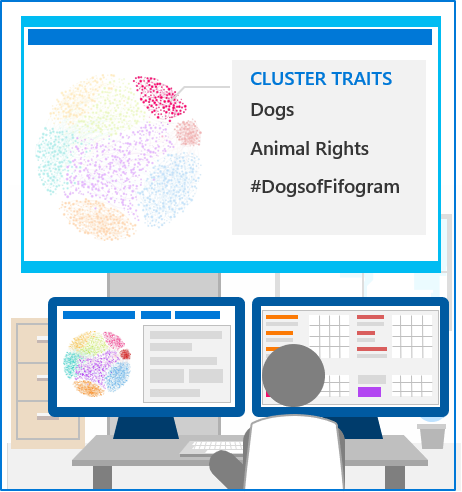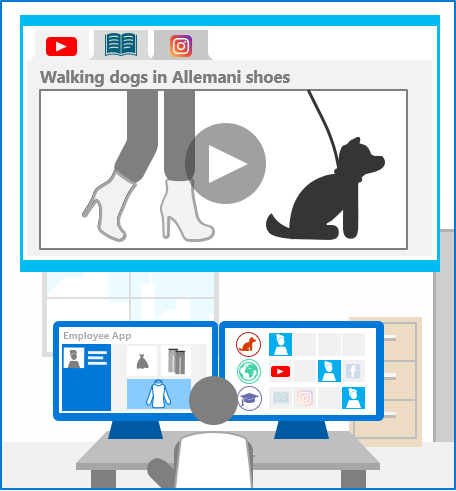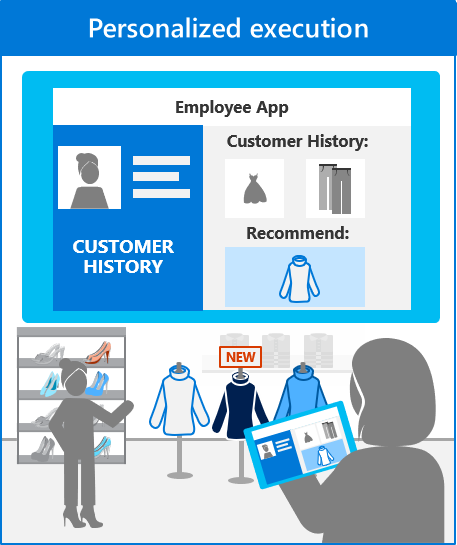
Is your customer journey living up to consumer expectations?
Experience is now everything in retail. As changing demographics and new technologies reshape the industry, customers expect highly personalized shopping engagements that are seamless across all channels, and provide exceptional service whenever and wherever they shop. While retailers understand their customers’ expectations are changing and growing, many are still struggling to keep up. The Intelligent Customer Journey scenario from Microsoft provides retailers with a compelling and differentiated solution that enables them to ‘Delight their Customers’ across every step of their customer journey.
Filter through the noise to transform disparate data sources into consumer-first strategies
 Consumers today are constantly connected to brands through digital channels, creating huge stores of consumer data. Unfortunately, retailers’ reliance on surveys, social listening, and large teams of data scientists limits their ability to develop insights from that data let alone in real-time, leaving them in a no-win scenario. Retailers who ignore this consumer data in favor of surveys, a go-to tactic for understanding consumers’ expectations and experiences, waste time and money collecting information that contains consumer bias and is often already largely available. For retailers who dip their feet into online data with social listening solutions, they risk getting a superficial, biased understanding of their brand’s standing with consumers; listening only focuses on the vocal minority of content creators as opposed to lurkers and observers. Meanwhile, diving headlong into the fray with large teams of data scientists poses scalability risks to many retail companies.
Consumers today are constantly connected to brands through digital channels, creating huge stores of consumer data. Unfortunately, retailers’ reliance on surveys, social listening, and large teams of data scientists limits their ability to develop insights from that data let alone in real-time, leaving them in a no-win scenario. Retailers who ignore this consumer data in favor of surveys, a go-to tactic for understanding consumers’ expectations and experiences, waste time and money collecting information that contains consumer bias and is often already largely available. For retailers who dip their feet into online data with social listening solutions, they risk getting a superficial, biased understanding of their brand’s standing with consumers; listening only focuses on the vocal minority of content creators as opposed to lurkers and observers. Meanwhile, diving headlong into the fray with large teams of data scientists poses scalability risks to many retail companies.
New analysis and insights solutions leverage artificial intelligence (AI) to bring audience segmentation back to the speed of culture and business, enabling retail companies to understand how audiences engage with brands and products by analyzing their interests and affinities in real-time. With machine learning-enhanced insights into the tertiary interests of shoppers through their online interactions, and by harvesting customer data throughout their retail journey, retailers can understand how and why consumers shop and interact with their brands. Plus, AI empowers retailers to identify white-space promotional opportunities defined by audience clusters they never would have known existed.
[msce_cta layout=”image_center” align=”center” linktype=”blue” linkurl=”https://info.microsoft.com/ww-landing-Retail-Trends-Playbook-2020-eBook.html?lcid=en-us&wt.mc_id=AID723257_QSG_SCL_327861″ linktext=”Get the Retail Trends playbook 2020″ ][/msce_cta]
Land content with optimized engagement strategies to inspire customers
 Digital transformation has given consumers access to more content than ever before. In a single minute, 500 hours of YouTube video are uploaded, 449 thousand tweets are posted, and 3.3 million posts are made to Facebook.1 With so much content available at their fingertips, consumers are no longer willing to interact with content that doesn’t resonate with them—80% of consumers say brands must demonstrate that they understand and care about customers before they will purchase from them.2 Unfortunately, many retailers can’t gain the insights they need to provide this level of personalization at scale. Despite the overwhelming customer desire for retailers to personalize the shopping experience, 63% of retailers admit to being unable to respond to consumer demands and insights in an agile manner.3
Digital transformation has given consumers access to more content than ever before. In a single minute, 500 hours of YouTube video are uploaded, 449 thousand tweets are posted, and 3.3 million posts are made to Facebook.1 With so much content available at their fingertips, consumers are no longer willing to interact with content that doesn’t resonate with them—80% of consumers say brands must demonstrate that they understand and care about customers before they will purchase from them.2 Unfortunately, many retailers can’t gain the insights they need to provide this level of personalization at scale. Despite the overwhelming customer desire for retailers to personalize the shopping experience, 63% of retailers admit to being unable to respond to consumer demands and insights in an agile manner.3
Retailers can leverage the customer intelligence they gain from audience segmentation solutions by combining them with powerful experience management tools to develop more effective engagement strategies. With insights into the interests and passions their audiences share, leading retailers deliver content that will resonate most with audiences, keeping them engaged. From curated promotions that enable retailers to effectively target and sell to specific customers, to location and intent-based recommendations that leverage customer intelligence by delivering the offers and products customers want, when they want them, a successful engagement strategy dramatically boosts revenue. Plus, by tracking the effectiveness of campaigns in real-time, retailers can react quickly to ensure campaigns, curated promotions, and recommendations land effectively with key audiences.
Enable employees to collaborate and deliver exceptional, personalized service
 While first-line workers are critical to representing the brand when engaging with customers in-store, many employees are unprepared to deliver the level of service customers expect due to consumers’ preference for relevant information. Without deep insights into products and people, employees are unable to deliver the level of personalization expected by customers. In fact, the standard of in-store service has fallen so low that 83% of shoppers think they are more informed than store associates.4
While first-line workers are critical to representing the brand when engaging with customers in-store, many employees are unprepared to deliver the level of service customers expect due to consumers’ preference for relevant information. Without deep insights into products and people, employees are unable to deliver the level of personalization expected by customers. In fact, the standard of in-store service has fallen so low that 83% of shoppers think they are more informed than store associates.4
Arming employees with intelligent tools enables them to collaborate internally and build stronger relationships with customers. With insights delivered on mobile devices, for example, sales associates are empowered to deliver relevant suggestions to consumers wherever they are in the store, and by aligning digital and physical channel operations, retailers provide employees with a full view of customer purchasing history and online activity, enabling them to seamlessly pick up service where customers left off online.
Deliver seamless, streamlined shopping with a true omnichannel experience
As e-commerce continues to grow, retailers are trying to find a new equilibrium between digital and physical channels. Unfortunately, while 87% of retail leaders agree omnichannel strategy is critical to business success, 74% are dissatisfied with the execution and progress of their omnichannel approach.5 Worse, consumers agree that their shopping experience across channels is not as connected as it should be. 61% of millennials find retail experiences to be disconnected from channel to channel.6
Leveraging new technologies to deliver a true omnichannel experience, retailers can meet shoppers where and when they want to shop. Aligning inventory across digital and physical channels enables retailers to provide services like buy online pick-up in store (BOPUS) and mobile checkout. Additionally, with a clear view of the customer across digital and physical channels, retailers can inform customer experiences with recommendations based on interactions on different channels.

Realize the Intelligent Customer Journey with Microsoft
The Microsoft Intelligent Customer Journey scenario enables retailers to maintain brand relevance and loyalty in an increasingly competitive landscape, imbuing retailers with intelligent systems to personalize engagements, deliver seamless shopping experiences, and provide exceptional services. While many companies are being swept away in a wave of data and content that limits their ability to stand out to consumers, the Intelligent Customer Journey scenario provides retailers with the back-end tools to supplement the customer journey and deliver experiences that delight, inspire, and build loyalty. To learn more about the Microsoft Intelligent Customer Journey for retail scenario and other technologies available in Microsoft’s suite of consumer goods and retail solutions, visit the Intelligent Customer Journey page.
[1] SmartInsights, What Happens Online in 60 Seconds? 2017
[2] Wunderman, Wantedness, 2017
[3] Deloitte, Consumer Experience in the Retail Renaissance, 2018
[4] Tulip, Understanding the Value of Store Associates, 2017
[5] ResearchLive, Retailers Struggling to Master Omnichannel, 2017
[6] Connected Shoppers Report, 2017




